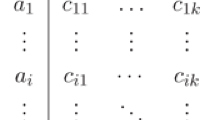Abstract
The Arrow-Pratt (A-P) definitions of absolute and relative risk aversion dominate the discussion of risk aversion and defining “more risk averse”. Ross (Econometrica 49:621–663, 1981) notes, however, that being A-P more risk averse is not sufficient for addressing many important comparative static questions. Consequently he introduces “a new and stronger measure for comparing two agents’ attitudes towards risk…”. Ross does not provide a corresponding measure of risk aversion. This paper uses a normalized measure of concavity to characterize the Ross definition of strongly more risk averse on bounded intervals. Other properties and uses of these normalized measures of concavity are also presented.
Similar content being viewed by others
Notes
Pratt (1990) points out several weaknesses of the Ross strongly more risk averse order.
The correct upper and lower bounds of outcome distributions are often specific to a particular decision problem. For many utility functions, utility is defined for every level of wealth, but the restriction to an interval is imposed to give Ross comparability over that interval. Thus, for the same utility function and different decision problems, the interval [a, b] can differ in location and size.
For a utility function such as the negative exponential function which displays A-P constant absolute risk aversion, any finite values for a and b are allowed. For constant relative risk aversion, however, the logarithmic and power functions require that a > 0 be satisfied.
Friedman and Savage (1948) use the second derivative of u(x) to define the utility premium.
Eeckhoudt and Schlesinger (2009) discuss the utility premium in the context of savings and other decisions and attribute the utility premium concept to Friedman and Savage (1948). The utility premium is also studied in detail in Stone (1970) and used in Menezes et al. (1980), Eeckhoudt and Schlesinger (2006), Menegatti (2007) and Crainich and Eeckhoudt (2008), among others.
In addition to being arbitrary to a scale factor, -u″(x) is a less desirable measure of risk aversion because of this unit issue as well.
Normalization factors exist that allow similar results in the competitive firm and insurance demand decision models.
Using the rate of substitution, instead of the risk premium, to quantify an individual’s reaction to risk increases turns out to be even more significant when the risk increases are of a higher degree, as shown in Liu and Meyer (2013a).
In their study of the relationship between changes in risk aversion and changes in prudence (− u‴(x)/u″(x)), Eeckhoudt and Schlesinger (1994) also work with these families of utility functions. They point out that, using the parameterization of the current paper, prudence remains the same but the A-P risk aversion increases as αu increases. Note also that these families of utility functions include the so-called “linex” family, where w(x) takes the form of any CARA utility function, as a special case (Denuit et al. 2013).
For a summary of the issues in this line of research, see Gollier (2001).
References
Arrow, K. J. (1974). Essays in the theory of risk-bearing. Chicago: Markham.
Crainich, D., & Eeckhoudt, L. (2008). On the intensity of downside risk aversion. Journal of Risk and Uncertainty, 36, 267–276.
Denuit, M., & Eeckhoudt, L. (2010). Stronger measures of higher-order risk attitudes. Journal of Economic Theory, 145, 2027–2036.
Denuit, M., Eeckhoudt, L., & Schlesinger, H. (2013). When Ross meets Bell: The linex utility function. Journal of Mathematical Economics, 49, 177–182.
Eeckhoudt, L., & Schlesinger, H. (1994). Increases in prudence and increases in risk aversion. Economics Letters, 45, 51–53.
Eeckhoudt, L., & Schlesinger, H. (2006). Putting risk in its proper place. American Economic Review, 96, 280–289.
Eeckhoudt, L., & Schlesinger, H. (2009). On the utility premium of Friedman and Savage. Economics Letters, 105, 46–48.
Friedman, M., & Savage, L. J. (1948). The utility analysis of choices involving risk. Journal of Political Economy, 56, 279–304.
Gollier, C. (2001). The economics of risk and time. Cambridge: The MIT Press.
Liu, L., & Meyer, J. (2013a). Substituting one risk increase for another: a method for measuring risk aversion. Journal of Economic Theory, forthcoming.
Liu, L., & Meyer, J. (2013b). Larger and riskier. Working paper.
Machina, M. J., & Neilson, W. S. (1987). The Ross characterization of risk aversion: Strengthening and extension. Econometrica, 55, 1139–1149.
Menegatti, M. (2007). A new interpretation for the precautionary saving motive: A note. Journal of Economics, 92, 275–280.
Menezes, C., Geiss, C., & Tressler, J. (1980). Increasing downside risk. American Economic Review, 70, 921–932.
Pratt, J. (1964). Risk aversion in the small and in the large. Econometrica, 32, 122–136.
Pratt, J. (1990). The logic of partial-risk aversion: Paradox lost. Journal of Risk and Uncertainty, 3, 105–113.
Ross, S. A. (1981). Some stronger measures of risk aversion in the small and in the large with applications. Econometrica, 49, 621–663.
Rothschild, M., & Stiglitz, J. (1970). Increasing risk I: A definition. Journal of Economic Theory, 2, 225–243.
Stone, B. K. (1970). Risk, return and equilibrium. Cambridge: The MIT Press.
Author information
Authors and Affiliations
Corresponding author
Additional information
Support from the Private Enterprise Research Center at Texas A&M University is gratefully acknowledged. We thank Louis Eeckhoudt and Stephen Ross for helpful comments and suggestions on an early draft. Two reviewers also provided helpful comments. An early version of this paper was presented at Risk and Choice: A Conference in Honor of Louis Eeckhoudt, Toulouse, France, July 13, 2012. We thank conference participants, especially Ed Schlee, for valuable comments.
Rights and permissions
About this article
Cite this article
Liu, L., Meyer, J. Normalized measures of concavity and Ross’s strongly more risk averse order. J Risk Uncertain 47, 185–198 (2013). https://doi.org/10.1007/s11166-013-9173-9
Published:
Issue Date:
DOI: https://doi.org/10.1007/s11166-013-9173-9



